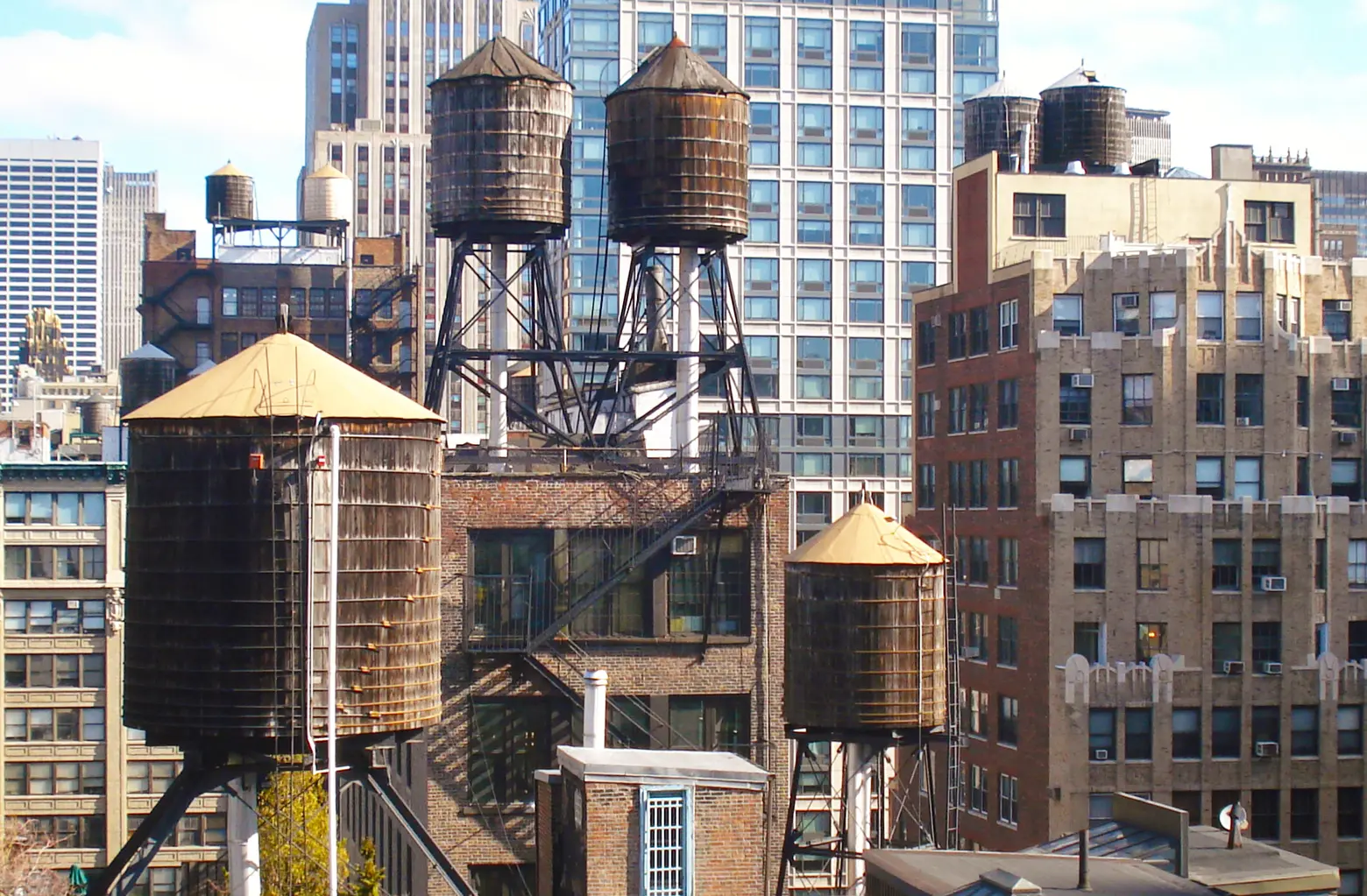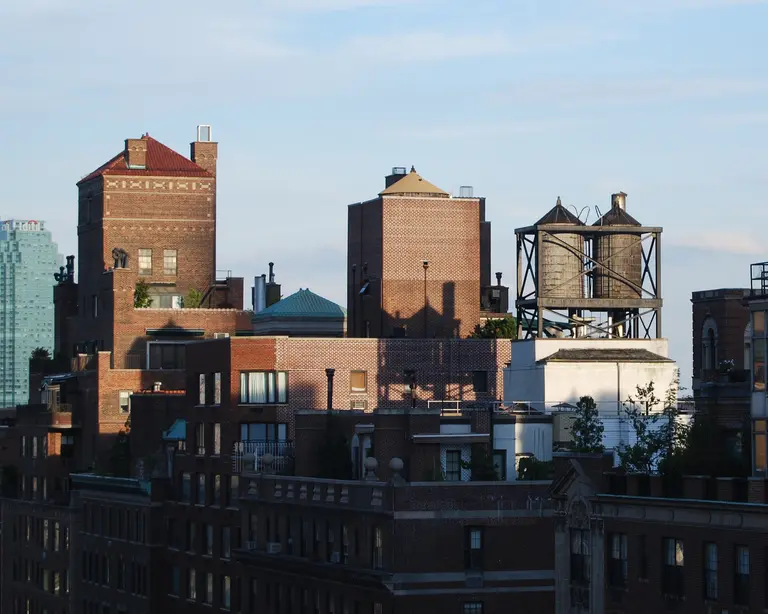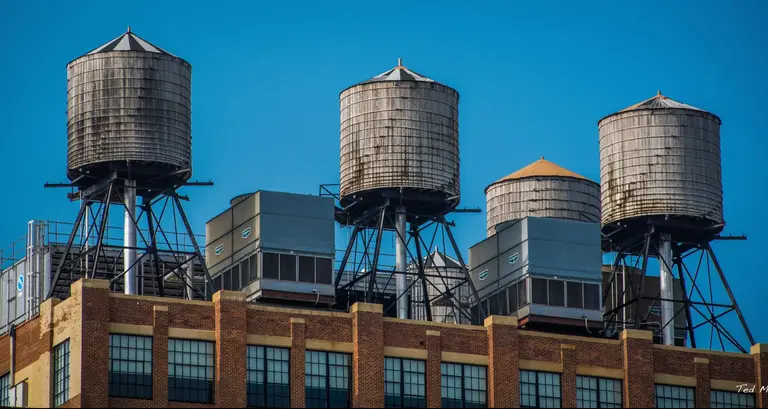Stuff you should know: What’s really in your water tower and what to expect when it’s replaced

Photo via Flickr cc
One of the most distinctive architectural features of New York City buildings is their water towers. Many New Yorkers assume these towers are a relic of another era—a time when people did store water in wooden barrels. In fact, nearly all of the city’s wooden water towers are still in use, and many are newer than one might expect. If a building is actually following city guidelines, their water tower should be no more than three decades old. Unfortunately, compliance is an ongoing problem when it comes to water tower inspections and maintenance. In fact, many of the city’s charming water towers aren’t so charming when you take a look inside the barrel.
Water isn’t the only thing in your building’s water tower
If you’re under the impression that you have access to great tap water because it comes directly from an aqueduct originating in the Catskills, you may not be entirely wrong, but you’re probably overlooking one key factor: what happens to this pristine water once it reaches your building in New York City.
With the average cost of replacing a water tower priced at $30,000, it’s not surprising that a lot of buildings have historically ignored their water towers far too long, but failing to maintain or replace a water tower in a timely manner is never a good idea. Sure, water towers contain water but there are also a lot of other things in those barrels. A recent report by City & State found that many of the city’s water towers also contain dead pigeons, cockroaches, grunge, and guck of all kinds, including E. coli and coliform bacteria. To ensure that New Yorkers don’t fall ill, all water towers must be inspected once a year and all reports are due annually on or before January 15. Failure to conduct a drinking water tank inspection or file a report annually is a violation of the law, but to date, the law hasn’t always been consistently enforced.
Last October, City & State reported that city officials don’t even know for certain how many water towers exist citywide (estimates range from 12,000 to 17,000 but no one is certain). In addition, to help bring the dirty drinking water situation under control, as of late 2018, there were seven council bills on the table aimed at reforming existing parts of the law. The proposed reforms include new requirements for inspectors submitting annual reports and guidelines on who can carry out a water tower inspection. Another proposed change would require inspection results to be recorded before, not after, tanks are cleaned to offer more accurate results of the quality of water typically available in a building. Yet another proposed change calls for unannounced spot checks of water tanks—a strategy that city health officials already use monitor and grade restaurants.
What to expect when your building’s water tower is replaced
Whether the full slate of proposed changes is passed is yet to be seen, but with the health of the city’s water towers finally on the radar, city buildings are currently under increased pressure to have their water towers inspected and replaced. If your building is willing to spend $30,000 to replace an old water tower, you should welcome the news, but a water tower replacement can also pose a few inconveniences.
First, brace yourself for a short water outage. Since buildings can’t go without water for long, however, water tower replacements do happen quickly. In most cases, buildings will need to shut down water for 12 hours but not more than 24 hours. Second, once the water comes back on, it will be cleaner but it might not smell or taste very good. In fact, before your water gets better, it might appear to get worse.
Martha Keller lives in a building on the Upper East Side that recently had its water tower replaced. While she welcomed the new tower, noting that she stopped drinking her tap water years ago, adjusting to the new tower’s water has also been a problem. Keller explained, “It’s been almost a month, and it was only last week that my cat started to drink the water again! I’m still not drinking it—smells awful, like a wood lot, but I guess it’s an improvement.” Keller’s reaction to her building’s new water tower is not unique. The majority of people who live in buildings with new water towers launch complaints about the taste and smell of the water, especially in the two weeks following the replacement. So, what is that smell?
A 2014 article in the New York Times discovered that at least two of the three companies that build water towers still use Sea Goin’ Poxy Putty, which was originally designed for use in ships’ hulls. The epoxy is not approved for use in drinking water, but the epoxy generally continues to be used since it naturally works well on damp surfaces. In addition, there is no indication that city health officials are worried about a bit of Sea Goin’ Poxy Putty getting into our drinking water. In 2014, a city official told the New York Times, “Most epoxy curing agents become inert once cured, and would not be expected to impact water quality.” If you’re concerned, you can do what many New Yorkers do—rely on bottled water instead.
Know your rights as a tenant
Even after your water tower is replaced and the initial smell of fresh wood dissipates, don’t be complacent. If a new tower isn’t maintained, old problems will quickly return. For this reason, it is important to know your rights as a tenant.
New York City stipulates that “all building owners must make residents aware of their rights to review the [water tower] inspection results.” In fact, building owners must keep inspection results and water quality test results on file for at least five years. Theoretically, tenants can also view water tank inspection results for their building online using this link, but our own investigation found that several buildings with water towers that have had recent inspections were not appearing in the city’s online database. This may simply confirm that reporting remains a major problem when it comes to building water quality.
RELATED:


























